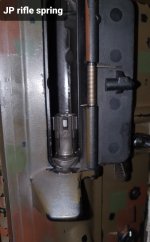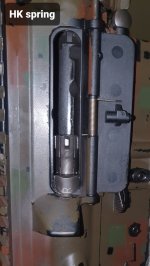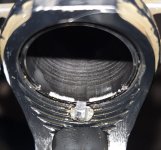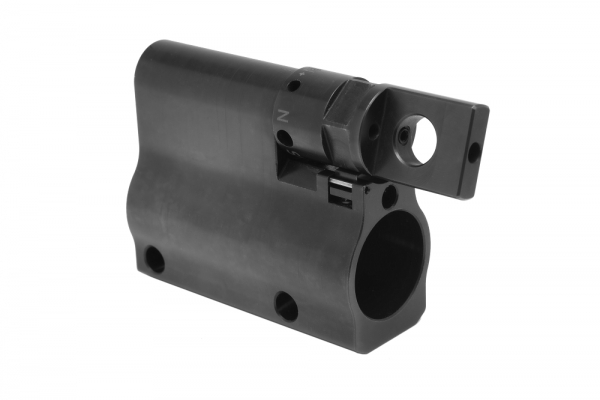Hello,
I got HK MR223 as used 1 year ago and it had had over 2k through it, the surface of the gun was in very nice condition but the barrel looked it could have been more than 2k. Shortly after buying it I shot 200-400 rounds with it in 2 days in -17C/1.4F to -10C/14F without cleaning and no issues turned up.
I have used it with legacy type silencer with gas port turned to silencer mode for 3k-4k and maybe 500 with brake. I just got a flowthrough suppressor though.
Anyways, this winter it has started to give failures to feed, gas block set to nonsuppressed, without a silencer, the first 2-8 shots depending on how cold the gun is, between -20C/-4F to -8C/18F.
Once it is warmed up it will feed but the bolt might still not lock open after the mag runs out.
The brass goes in to a very small pile at direction of 15:30 once it gets going.
Could you please help me what could be the source of this problem?
Could it be that the legacy suppressor has slightly clogged the gas port? My firing has been steady except for few trainings with rapid fire but they were not long lasting. Maybe I should run it hot to get rid of any debris there?
Could it be any of the springs?
I have tried running it with normal grease, extra grease and now bone dry. The problem does not seem to change at all with lubes.
I am shooting 55gr Geco as my training ammo, I have not yet tried if 77gr Sellier loads produce the same problem. I have also tried PMC 55gr and it also had same issues.
I am open to more questions and of course, answers
EDIT 12/2023
In hindsight, this could be my HK gas block that created this. I had it stuck and had to turn it one day, (I used it quite often, really, but managed to shoot few K ammo inbetween) and when turning from S to N, it somehow failed. As a result it stuck to either side but wiggled a bit.
This summer (!!!!) I noticed I got few failure to feed at the range while prepping for a comp. I immediately assumed it was the gas block because I had read a much more of them over here. I used a magnet (lol) to hold the gas setting in place and rifle has ran very well through bushes and firing maybe 600-800 rounds so far (dry spell).
I hate that adjustable gas blocks can cause so much havoc. Should have known that it was fubar when it wiggled around. I tried fixing it myself but could not get the spring to apply pressure enough so I am guessing some metal piece broke off.
If I remember right, in the summer, I can run the rifle with Suppressed setting without the can.
But in the winter time, I think I had some problems with the low pressure cans as it is indeed is quite low pressure. The legacy can is ofc fine.
So, I am going to change to original (fixed) gas block and keep running the low pressure can.
I got HK MR223 as used 1 year ago and it had had over 2k through it, the surface of the gun was in very nice condition but the barrel looked it could have been more than 2k. Shortly after buying it I shot 200-400 rounds with it in 2 days in -17C/1.4F to -10C/14F without cleaning and no issues turned up.
I have used it with legacy type silencer with gas port turned to silencer mode for 3k-4k and maybe 500 with brake. I just got a flowthrough suppressor though.
Anyways, this winter it has started to give failures to feed, gas block set to nonsuppressed, without a silencer, the first 2-8 shots depending on how cold the gun is, between -20C/-4F to -8C/18F.
Once it is warmed up it will feed but the bolt might still not lock open after the mag runs out.
The brass goes in to a very small pile at direction of 15:30 once it gets going.
Could you please help me what could be the source of this problem?
Could it be that the legacy suppressor has slightly clogged the gas port? My firing has been steady except for few trainings with rapid fire but they were not long lasting. Maybe I should run it hot to get rid of any debris there?
Could it be any of the springs?
I have tried running it with normal grease, extra grease and now bone dry. The problem does not seem to change at all with lubes.
I am shooting 55gr Geco as my training ammo, I have not yet tried if 77gr Sellier loads produce the same problem. I have also tried PMC 55gr and it also had same issues.
I am open to more questions and of course, answers
EDIT 12/2023
In hindsight, this could be my HK gas block that created this. I had it stuck and had to turn it one day, (I used it quite often, really, but managed to shoot few K ammo inbetween) and when turning from S to N, it somehow failed. As a result it stuck to either side but wiggled a bit.
This summer (!!!!) I noticed I got few failure to feed at the range while prepping for a comp. I immediately assumed it was the gas block because I had read a much more of them over here. I used a magnet (lol) to hold the gas setting in place and rifle has ran very well through bushes and firing maybe 600-800 rounds so far (dry spell).
I hate that adjustable gas blocks can cause so much havoc. Should have known that it was fubar when it wiggled around. I tried fixing it myself but could not get the spring to apply pressure enough so I am guessing some metal piece broke off.
If I remember right, in the summer, I can run the rifle with Suppressed setting without the can.
But in the winter time, I think I had some problems with the low pressure cans as it is indeed is quite low pressure. The legacy can is ofc fine.
So, I am going to change to original (fixed) gas block and keep running the low pressure can.
Last edited:





